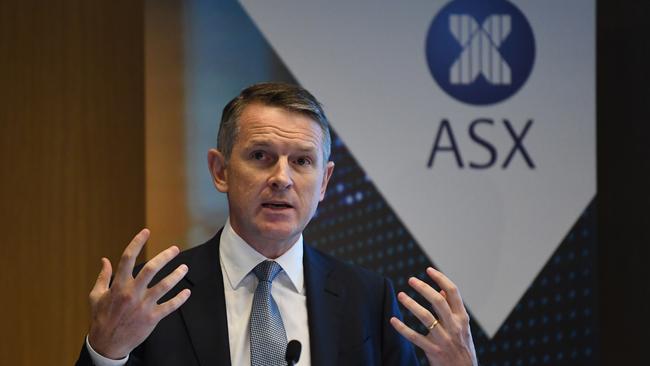Market volatility good for ASX Ltd
Geopolitical tensions have been a boon for ASX Ltd, fuelling trading volumes across its products.

Rising geopolitical tensions and financial market volatility have been a boon for the ASX, fuelling trading volumes that lifted annual net profit to a record and highlighting the relatively positive image of Australia.
ASX chief executive Dominic Stevens said the local economy and financial markets were benefiting from looming annual surpluses in trade, the current account and the Federal Budget as well as low exchange and interest rates and high commodity prices.
That contrasted with protracted Brexit negotiations, US-China trade tensions and protests in the regional financial centre of Hong Kong.
“So if you put Australia in the context of the world it is feeling at the better end of that,” Mr Stevens said.
ASX will pay a special dividend on top of an increased regular payout after booming equity and futures market volumes pushed statutory net profit up 10.5 per cent.
ASX returned $492.0 million after tax, up $46.9m, with each of ASX’s four main businesses growing and interest earnings on settlement deposits also higher. Chief executive Dominic Stevens said there was also an increasing appetite from customers for technical connections and information services.
The ASX has been spruiking its credentials for both foreign and technology-oriented listings, bringing with it a “export market” of professional services such as investment banking, accounting and auditing”
The total number of listed companies fell by 16 to 2269 at the end of June. But the ASX highlighted steady success in its campaign to attract more technology and foreign companies which totalled 202 and 275 respectively as evidence that it was combating a trend of falling company numbers in other developed markets such as the US.
In Australia the number of companies had been increasing and growing as a share of gross domestic products.
“While this also includes valuation effects, it shows that — in Australia at least — the average
listed company is becoming larger and the listed market remains very sizeable and relevant, “
Mr Stevens said.
“While we see growing private equity and venture capital markets providing value, we believe the transparency and liquidity of the listed market is the fundamental bedrock of the capital allocation process in a market economy.”
The market sell off in late October after US Federal Reserve chairman Jerome Powell said official interest rates were “a long way from neutral” sparked a long wave of volatility in the markets, amplified by glowing trade tensions between China and the US.
But when the Fed switched back to easing rates earlier this year it triggered a surge trading activity as companies and investors used the ASX derivative markets to hedge their interest rate exposure.
Volumes across the ASX business boomed in 2018-19, with the share volumes up 23 per cent, futures volumes up 10 per cent and over the counter derivative clearing surging by 54 per cent.
Revenue rose 5 per cent to $863m, which was half the rate of growth in expenses — up 9.9 per cent to $214.8m.
“ASX’s diversified business model continues to deliver attractive earnings across different business cycles without compromising our commitment to operating markets of high quality,” Mr Stevens said.
ASX will pay a final dividend of 114.3 cents per share, a rise of 4.8 per cent and making 228.7 cents a share for the year at a payout ratio of 90 per cent of profits.
Shareholders will also receive a 129.1 cents a share special dividend from the proceeds of the sale of its stake in market information business IRESS.
The surge in activity has fuelled an extraordinary rise in the ASX shares, which passed their 2007 peak in October and closed at a record high of $89.20 last week, having added 46 per cent since January.
Shares initially dropped in line with a broad, US market-inspired sell off, rallied higher before falling later in the day as the market tumble gathered pace to close down $2.40, or 2.74 per cent, at $85.18.



